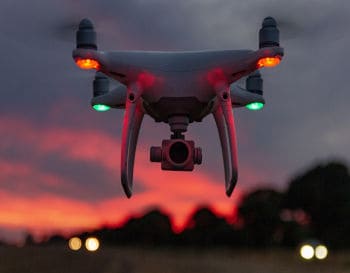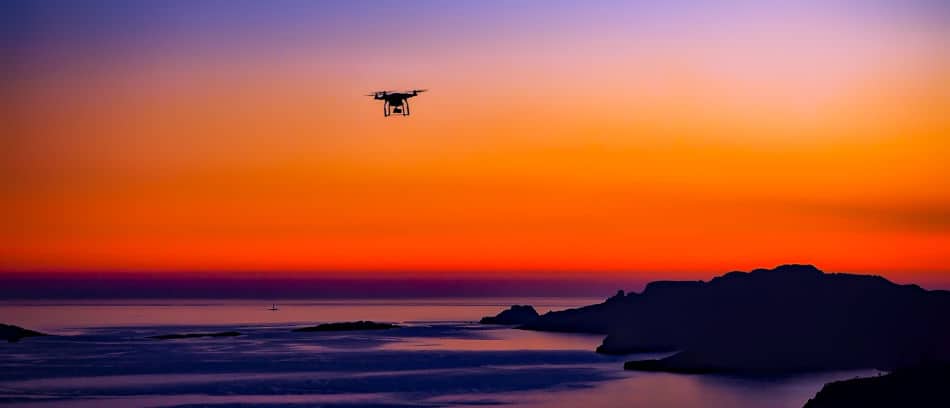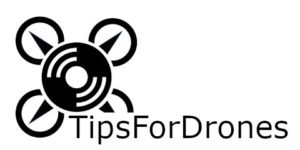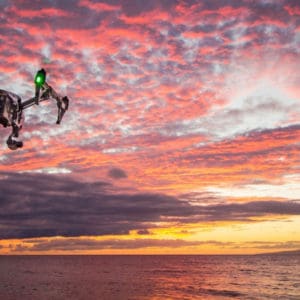I was asked to take a good picture of a party at night with my drone. In my country (Austria), the regulations for flying drones are very strict, and there are many things to consider when you want to fly at night. So, I did some research, and here is an overview of the regulations in some other countries as well as some technical tips.
Is it possible to fly a drone at night? It depends on which country you want to fly it in. In some countries, flying drones is prohibited at night but exceptions can be requested. Hobbyists in the US can fly at night, but they have to follow basic safety rules. From a technical point of view, flying at night is not a problem, and there are many tools that can support the flight.
There are two main aspects of the regulations related to flying a drone at night—technical and legal. In both cases, there are many things to consider and take into account.
What is important to remember when flying a drone at night?
The first question you have to answer is “Are you a hobbyist or a professional?” This question is crucial, because in many countries there are different laws for these two kinds of pilots.
The next step is to look at your country’s national laws for drones. Generally, each country has an association where the regulations for drones are published. These laws usually relate to the weight of the drones, which can be found in the manual of a drone.
For the night flight itself, the same rules apply as for flights during the day, such as an absolute flight ban near airports.
The most important point to remember when flying a drone at night is to know your flight area. Objects look different, and power lines are nearly invisible at night. So, be familiar with the place you’re flying in, and conduct a test flight during the daytime.
Take someone with you: Four eyes see more than two. An assistant can illuminate the place, especially during the critical phases of take-off and landing, and someone by your side calms you down during exciting moments.

During the flight, especially focus on establishing a general increased altitude and a greater distance from other objects. It’s hard to estimate the distances if you can only see with the lights of the drone.
The last point is to keep your eyes on your drone. During the daytime, it’s sometimes difficult to see the position of your drone, and that is even more difficult at night. If you lose sight of the drone, use the “Come Home Button” immediately.
From a technical point of view, the navigation lights are the most important components. They show you how the drone is positioned and in which direction the drone is aligned.
For first-person view (FPV) flights at night, also take a second person with you to control the area around your drone. An infrared radiation (IR) camera will allow you to see enough at night. If you turn off the front LEDs, you might have a better view because there is no reflection in your onboard camera.
Can I fly a drone in my country at night?
That depends on the reason for the flight, whether you’re a hobbyist or a professional, and the laws of the country you want to fly in. These laws change frequently, so be sure that you’re up to date. You can find a link to the laws in numerous countries below.
In the United States, you can fly as a hobbyist without any license. You only have to follow basic safety rules, which are published by the Federal Aviation Administration (FAA).
In some European countries, there is a general night-flight ban on drones. Therefore, you must request an exception, which is associated with significant safety requirements and necessitates a special test of the drone and the pilot.
Here is a list of some countries with a link to the respective national government or aviation associations, where you can find up-to-date regulations.
| Country | Website |
| United States | https://www.faa.gov/uas/ |
| Canada | https://www.tc.gc.ca/ |
| Australia | https://www.casa.gov.au/ |
| New Zealand | https://www.caa.govt.nz/ |
| United Kingdom | https://dronesafe.uk/ |
| India | http://dgca.nic.in/ |
| China | http://www.caac.gov.cn/ |
| Japan | http://www.mlit.go.jp/ |
| Russia | https://gcaa-gy.org/ |
| France | https://www.ecologique-solidaire.gouv.fr/ |
| Germany | https://www.bdl.aero/ |
| Italy | https://www.enac.gov.it |
| Spain | https://www.fomento.es/ |
| Austria | https://www.austrocontrol.at/ |
| Poland | http://www.ulc.gov.pl/ |
Technical components for flying a drone at night
The navigation, or position, lights are the most important components for flying a drone at night. They show you how the drone is positioned and in which direction the drone is aligned.

Navigation lights are only for you and other aircraft to increase visibility and not to illuminate the area around the drone.
Navigation lights of planes and helicopters:
A red navigation light is located on the leading edge of the left wingtip and a green one on the leading edge of the right wingtip, or for helicopters, on the left and right of the cockpit. A white navigation light is positioned as far out as possible on the tail. High-intensity strobe lights are also located in these positions. They are used as anti-collision lights and flash twice after a short break. A red rotation beacon is also part of the anti-collision lights.
If you want to install navigation lights, it might be useful to use the same setup as a plane or helicopter.
To navigate by FPV, an IR camera is the best way to see at night.
Sometimes it makes sense to illuminate the area under the drone. There are some freaks who sell LED systems with over 130,000 lumens. That’s really bright and can be used to take great photos and videos or support people who work short nights and need a lot of light.
What is an infrared camera?
An IR camera visualizes electromagnetic radiation outside the visible light, which has a longer wavelength. Infrared cameras can display the different temperatures of given objects.
Every object has its own temperature, making it possible to see and orientate at night. Generally, a grayscale image is used when flying at night, and for inspections such as for buildings, a rainbow palette is used for the images.
These inspections show you how well the building is sealed against heat loss. For exact measurements of temperature, the camera must be calibrated regularly.
Can drones see in the dark?
Yes, they can. Drones with infrared cameras see at low light as well as at night. Infrared is electromagnetic radiation with longer wavelengths than those of the visible light.
Can drones see inside your house at night?
Generally, they can see as well as a human. So, if you have no curtains or blinds, anybody can look into your house through your windows. Some drones have infrared cameras, but they can only see the same as a normal camera, just with less light. Industrial drones also use thermal imaging cameras, but they can only see if your house loses heat through your insulation.
When is the sunset or sunrise?
Some laws use the sunset and sunrise times for the definition of a night flight. “Sunset” is defined as the daily disappearance of the upper limb of the sun below the horizon. This time depends on the latitude and longitude of the viewpoint. There are many websites and apps to find out the sunset and sunrise times of your location.

Is it legal to fly a drone over someone’s property?
Check and follow all local laws before flying over private property. Every country has its own regulations, but to be on the safe side, getting the consent of the landowner is always advisable.

